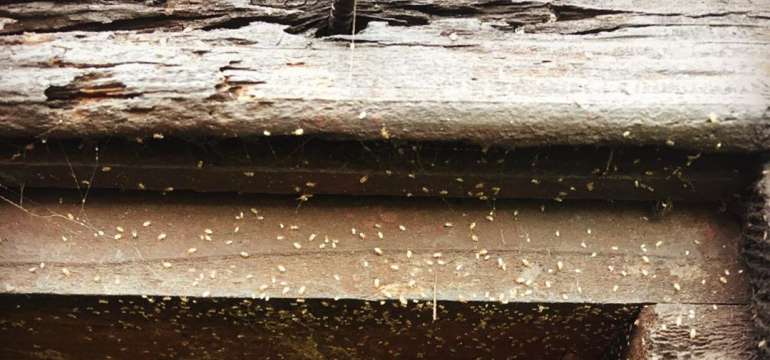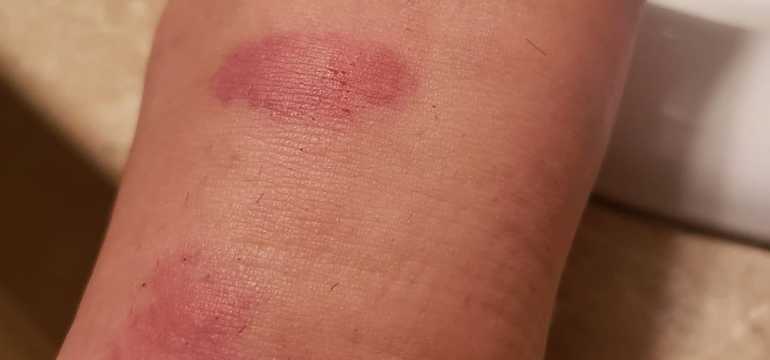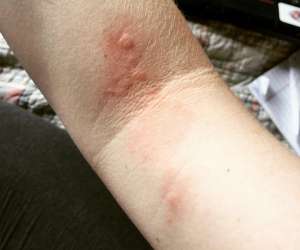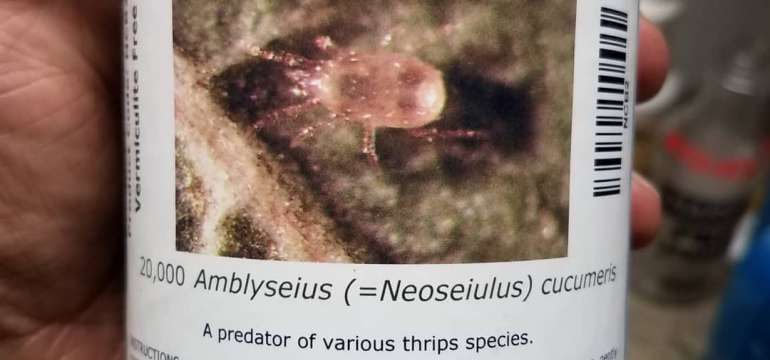Household pests are generally unwelcome. While wood mites may not be among the ugliest, most disgusting, or most harmful house pests, they are still unwanted denizens of some homes, garages, sheds, or workshops. Let’s talk about the characteristics of wood mites, including what they look like, what they eat, and what attracts them to a space. Then we will talk about how to get rid of wood mites and how to ensure that they will really stay gone.
What Do Wood Mites Look Like?
 Wood mites are small white bugs, so you may hear people refer to them as “white wood mites.” They can look rather spider-like, and in fact, you may hear people refer to them as spider mites. Unlike other insects, these pests have eight legs.
Wood mites are small white bugs, so you may hear people refer to them as “white wood mites.” They can look rather spider-like, and in fact, you may hear people refer to them as spider mites. Unlike other insects, these pests have eight legs.
If you get a close look at one under a microscope, you may notice that its body is translucent white, a bit like cloudy quartz. Even the full-grown adult mites are very tiny, usually reaching about 0.5 mm in length. When white mites live on plants in nature, they often leave silky, cobwebby material behind them.
When they live outdoors, they feast on plants, and they can actually wreak significant havoc on a garden. Indoors, their diet is composed mainly of decomposing wood or woody material. However, they are not destructive, like termites. Termites eat through wood, causing the destruction themselves, whereas white wood mites simply take advantage of decay that is already occurring.
So if you’re finding a lot of wood mites in one particular spot in your home or elsewhere around your property, you may want to ask yourself what might be attracting them. Could you possibly have wood decay going on that you don’t know about?
Is it possible that a moisture problem had developed, one that you were previously unaware of? Unless you tackle the root cause of the problem, the mites’ food source, you are likely to face a recurrence of the infestation, even if you manage to root out the first wave of them.
Wood mites are indeed visible to the naked eye, which can be a good thing, since you’ll be able to tell if you’ve gotten rid of them or not, and you will be able to identify where most of them are congregating.
What Do Wood Mites Infest?
 Wood mites can infest a variety of furniture, fixtures, and structural elements of your home. However, they don’t actually burrow into the material. Usually, they tend to nestle in the dust and particles and debris nearby. So, for example, in a workshop or garage workspace where there are a lot of dust, grit, and detritus, the wood mites are likely to hunker down and settle in.
Wood mites can infest a variety of furniture, fixtures, and structural elements of your home. However, they don’t actually burrow into the material. Usually, they tend to nestle in the dust and particles and debris nearby. So, for example, in a workshop or garage workspace where there are a lot of dust, grit, and detritus, the wood mites are likely to hunker down and settle in.
They tend to like old, damp wood, so you might find them in a woodpile, or in wood scraps that you are keeping around for your next project. Another place you might see them is in the wood shavings or wood-based substrate that fill the bottom of a snake cage, a hamster cage, or some other pet enclosure.
Wood mites can also be found in stacks of old papers, old books, or anything wood-based that’s in piles or cluttered drawers. Cardboard boxes filled with junk might make a good home for them, or they may choose spots in the home that are rarely dusted or vacuumed. You may also find white mites in linen closets or in the curtains.
Mites Bites
 Do wood mites bite? No, wood mites don’t bite humans. The word “mite” is used of many different tiny insects, so if you’re suffering from bites due to critters you believe are mites, it’s time to take a closer look at the bites themselves and at the insects, you think might be causing them.
Do wood mites bite? No, wood mites don’t bite humans. The word “mite” is used of many different tiny insects, so if you’re suffering from bites due to critters you believe are mites, it’s time to take a closer look at the bites themselves and at the insects, you think might be causing them.
Also, dust mites do not bite. They may accidentally end up on your clothes, but they’re not parasitic; they would prefer to be on a stable, dusty surface instead of on you. So you won’t find yourself covered in wood mite bites or dust mite bites.
However, when you have dust mites in your home, their fecal matter and the bits of dead ones’ bodies mingle with the typical house dust, and you might find yourself reacting to that change in the dynamic of your home. Since the dust in a home with dust mites is more protein-rich, it can trigger allergies in some individuals.
The allergy usually shows itself in symptoms very similar to hay fever or asthma, with breathing issues, itchy noses, and watery red eyes becoming an issue. In addition, white mites have long hairs that they shed and regrow every so often, and those hairs are an added problem, resulting in a mix that’s not friendly to those in your home with sensitivities to allergens.

Oak mite bites
Other types of mites do bite, however, and their bites can result in rash-like bumps on the skin. Prickly pain, itching, irritated or swollen skin, tiny blisters, or similar symptoms may indicate a mite bite. Oak mites usually inhabit oak trees, but if they fall onto you while you’re outdoors, they may express their displeasure by biting you. Oak trees whose leaves have crusty brown edges are probably infested with oak mites, so steer clear of the area underneath them. Oak mite bites resemble pimples and itch a lot, and they may stick around for up to two weeks before healing.
If you suspect that some kind of mite bit you, it’s a good idea to have a doctor check out any rashes or bites to ensure that they don’t worsen or cause complications.
Ways to Get Rid of Wood Mites

Identify the Target Areas
First, you need to identify where they are primarily congregating. Chances are since you have noticed the problem; you already have some idea of the places that are infested; but you may have to dig a little deeper, removing baseboard trim or flooring pieces, shifting furniture, pulling aside paneling, or otherwise conducting a more thorough investigation.
Purchase Anti-Mite Pesticide Spray
Next, you’ll need the right kind of pesticide spray to get rid of these unsightly little critters. You can purchase anti-mite pesticide at a local home and garden store, or at a home improvement store, or even at Walmart or a similar retail location. You can also order an anti-mite pesticide online if you prefer. In fact, some types of pesticides are specially formulated to target specific kinds of mites.
When you get your hands on the pesticide, you need to kill the mites, read the instructions carefully. Be sure to observe any safety protocols that the manufacturer has included, and note whether the spray has the potential to stain or damage any of the textiles or belongings around the area.
Clear Out and Clean the Area
Before you spray the pesticide, clean the area thoroughly. Wipe any affected belongings down with rags, warm water, and mild soap. For furniture, you can also use a vacuum attachment to eliminate dust and wood mites or dust mites. For items that are extremely infested with mites, consider bagging them up and throwing them away and purchasing replacement items.
Freeze the Mites and Mite Eggs
Some items can also be treated for mites using the freezing technique. Mites can’t survive the conditions in a freezer, so if you have small household objects that you suspect may have been infested by mites, you can place them in the freezer for 4-6 hours and let the extreme temperatures kill them off. Neither adult mites nor mite eggs can survive in those conditions, so after the required freezing period, those items will be purged of live mites.
Use the Spray
After you’ve cleared everything from the area and cleaned all the affected objects, you can begin treating the space with the pesticide spray. Remember to wear a mask or hold the aerosol can at arm’s length, so you don’t inhale any of the spray. Compress the trigger and sweep the spray over the affected zone, covering all the target areas where the mites have congregated.
Buy Predator Mites
There’s another way you can address a mite infestation, but it’s not for the squeamish. If you’ve got a snake cage or cigar humidor or some other area that’s been invaded by wood mites, you can order hypoaspis mites online or at a garden supply store. These mites like to feast on wood mites. They are natural predators for the pests you’re trying to get rid of, so you can set them free in the area, and they will keep eating wood mites and wood mite eggs until there are no more left. And after that, the hypoaspis mites will die off themselves, since their food source is gone.
If your white mites are becoming a problem outdoors rather than indoors, you’ll need to take action there as well. Purchase an outdoor mite-focused insecticide like Reclaim IT and spray the area, with particular attention to badly infested plants.
After you’re done applying it the vegetation, use it along the frames of exterior doors and windows, along the foundation, around the eaves, and wherever plumbing or electrical elements enter your home. A thorough application like this will provide a buffer, discouraging mites from outside from entering your home through those access points again.
You can also use Reclaim IT indoors. Consider applying it to cracks, around the interior side of windows and doors, along baseboards, and at the edges of cabinets. This product is designed to kill and repel mites, and it should keep them from re-infesting the area for up to 90 days, whether you are using it indoors or outdoors.
How to Prevent Wood Mites
 Once you’ve gotten rid of the wood mites, you need to make sure that they will not come back. There are several ways to do this, but primarily these tactics involve keeping your home, outbuildings, and other spaces neat and clean. When you focus on cleanliness and neatness, the dust mites won’t have a place where they want to gather, breed, and spread.
Once you’ve gotten rid of the wood mites, you need to make sure that they will not come back. There are several ways to do this, but primarily these tactics involve keeping your home, outbuildings, and other spaces neat and clean. When you focus on cleanliness and neatness, the dust mites won’t have a place where they want to gather, breed, and spread.
Check for Moisture Problems
Do you have areas in your home where you suspect moisture, mold, and mildew may be an issue? Those areas are ripe for infestation by wood mites. If you want to get rid of wood mites once and for all, it’s time to address those little niggling moisture issues you’ve been ignoring. In the long run, it will be better for the structural health of your home, too.
If you let the problem go on, your home will likely attract more unsavory pests besides the harmless little wood mite. So check for drips, leaks, or poorly insulated areas. Ensure that the foundation of your home isn’t cracked, and make certain that the spaces around doors and windows are all thoroughly sealed and secure. With any potential moisture issues resolved, you are well on your way to ensuring that you don’t have to treat a wood mite issue ever again.
Dust Your Interior Spaces Regularly
Dusting isn’t anyone’s favorite household task, but it’s an important one if you want to keep your home free of wood mites and dust mites. Wipe down every surface, including furniture, trim, windowsills, picture frames, ledges, and handles.
Using a dry cloth or paper towel simply sends the dust and mites spinning into the air, after which they can settle back onto the surfaces again. Instead, try using a damp cloth, towel, or rag, so the mites and dust actually stick to the cloth. You can then wash the rag to kill off all the mites, or bag it up and throw it away if you prefer. Once the mites are gone, and you have sprayed everything with insecticide, stay on top of the dusting task, doing it at least once per week.
Clean the Furniture
Let’s suppose you have found wood mites in, on, or around pieces of wood furniture in your home, such as your dining table, chairs, sideboard, cabinets, or bookcases. Mites tend to gather in areas that aren’t cleaned often, such as the back corners of shelves, the edges or undersides of tables, and in hard-to-clean grooves.
Use furniture cleaner or wood cleaner, with rags and soft brushes, to thoroughly clean every little nook and cranny of every piece of wood furniture in your home, especially those where you’ve seen white wood mites. You’ll need to keep up the habit of wiping down the furniture every week or so, to keep mites at bay and to keep the pieces in the best possible shape.
For furniture, you can also use a benzyl benzoate insecticide that is specifically marked as being designed for mite control. Check the label to be sure it is rated safe for indoor use. Feel free to apply it on your furniture as long as you adhere to the manufacturer’s instructions and recommendations for use.
Tidy Up the Clutter
Check your home for stacks of papers, piles of books, and baskets of random odds and ends. We all have those elements in our homes, but if they get out of hand, they can provide perfect grounds for a mite infestation. Go through stacks of papers and file those you plan to keep, recycling the rest.
Dust off treasured books and replace them, reshuffling them periodically, so they don’t sit too long in one spot. Empty baskets of odds and ends, picking up the items one at a time and finding a permanent home for each one. Check the baskets or bins for mites and dispose of them if they are infested.
If you have discovered wood mites in your home or another space on your property, don’t despair. As pests go, they’re not too hard to get rid of. What’s more important is identifying the reason they set up shop in the first place. Since they like warm, damp, corroding, or decaying spaces with lots of cover and clutter, you’ll need to address those issues before you can be sure that the wood mites won’t reappear.
Check for leaks or moisture issues, inspect your woodwork, and make sure you keep your living spaces dusted and tidy. With those measures in place, you should be able to enjoy life as usual, without the ick factor of invading wood mites.
- How to Get Rid of Wood Mites - September 24, 2020
- Can You Have Stained Doors With Painted Trim? - May 27, 2020
- Is Duct Tape Flammable? and Other Burning Questions About Duct Tape - April 2, 2020
